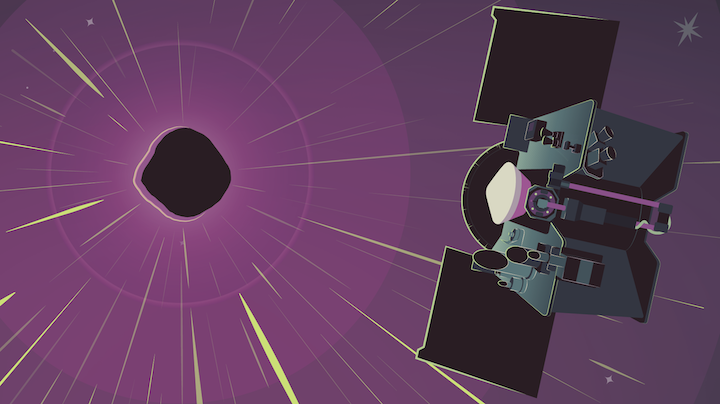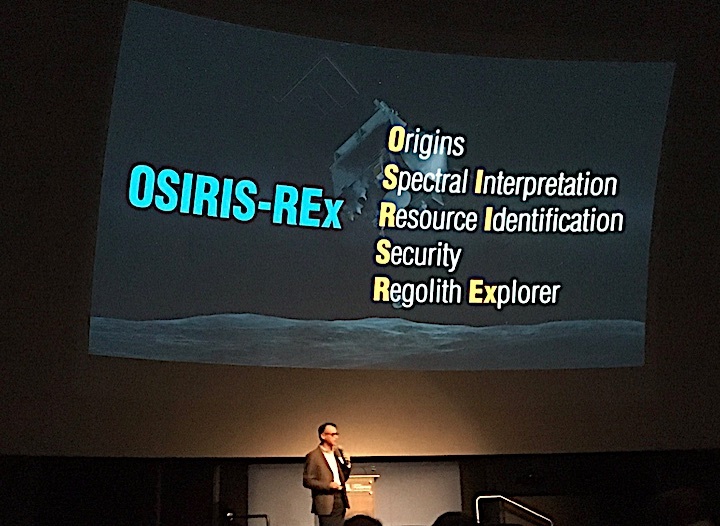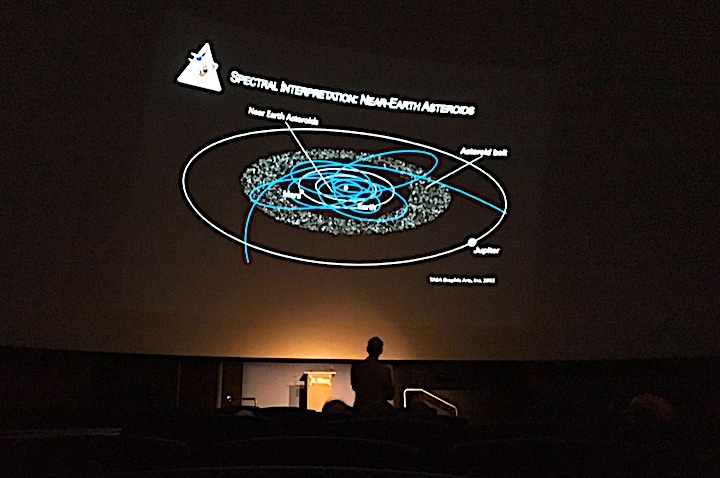On Nov. 14, NASA’s OSIRIS-REx spacecraft stretched out its robotic sampling arm for the first time in space. The arm, more formally known as the Touch-and-Go Sample Acquisition Mechanism (TAGSAM), is key to the spacecraft achieving the primary goal of the mission: returning a sample from asteroid Bennu in 2023.

This image, showing the OSIRIS-REx Touch-and-Go Sample Acquisition Mechanism (TAGSAM) sampling head extended from the spacecraft at the end of the TAGSAM arm, was taken by the SamCam camera on Nov. 14, 2018 during a visual checkout of the spacecraft’s sampling system. A similar observation will be taken after TAG to help document the asteroid material collected in the TAGSAM head. Credit: NASA/Goddard/University of Arizona
As planned, engineers at Lockheed Martin commanded the spacecraft to move the arm through its full range of motion – flexing its shoulder, elbow, and wrist “joints.” This long-awaited stretch, which was confirmed by telemetry data and imagery captured by the spacecraft’s SamCam camera, demonstrates that the TAGSAM head is ready to collect a sample of loose dirt and rock (called regolith) from Bennu’s surface.
“The TAGSAM exercise is an important milestone, as the prime objective of the OSIRIS-REx mission is to return a sample of Bennu to Earth,” said Dante Lauretta, OSIRIS-REx principal investigator at the University of Arizona, Tucson. “This successful test shows that, when the time comes, TAGSAM is ready to reach out and tag the asteroid.”
YEARS OF INNOVATION
Lockheed Martin engineers spent more than a decade designing, building, and testing TAGSAM, which includes an 11-foot (3.35-meter) arm with three articulating joints, a round sampler head at the end of the arm that resembles the air filter in a car, and three bottles of high-pressure nitrogen gas.
This test deployment was a rehearsal for a date in mid-2020 when the spacecraft will unfold the TAGSAM arm again, slowly descend to Bennu’s surface, and briefly touch the asteroid with the sampler head. A burst of nitrogen gas will stir up regolith on the asteroid’s surface, which will be caught in the TAGSAM head. The TAG sequence will take about five seconds, after which the spacecraft will execute small maneuvers to carefully back away from Bennu. Afterward, SamCam will image the sampler head, as it did during the test deployment, to help confirm that TAGSAM collected at least 2.1 ounces (60 grams) of regolith.
The TAGSAM mechanism was designed for the key challenge unique to the OSIRIS-REx mission: collecting a sample from the smallest planetary body ever to be orbited by a spacecraft. “First-of-its-kind innovations like this one serve as the precursor for future missions to small bodies,” said Sandy Freund, systems engineer manager and Lockheed Martin OSIRIS-REx MSA manager. “By proving out these technologies and techniques, we are going to be able to return the largest sample from space in half a century and pave the way for other missions.”
A MONTH OF TESTING
The unfolding of the TAGSAM arm was the latest and most significant step in a series of tests and check-outs of the spacecraft’s sampling system, which began in October when OSIRIS-REx jettisoned the cover that protected the TAGSAM head during launch and the mission’s outbound cruise phase. Shortly before the cover ejection, and again the day after, OSIRIS-REx performed two spins called Sample Mass Measurements. By comparing the spacecraft’s inertial properties during these before-and-after spins, the team confirmed that the 2.67-pound (1.21-kilogram) cover was successfully ejected on Oct. 17.
A week later, on Oct. 25, the Frangibolts holding the TAGSAM arm in place fired successfully, releasing the arm and allowing the team to move it into a parked position just outside its protective housing. After resting in this position for a few weeks, the arm was fully deployed into its sampling position, its joints were tested, and images were captured with SamCam. The spacecraft will execute two additional Sample Mass Measurements over the next two days. The mission team will use these spins as a baseline to compare with the results of similar spins that will be conducted after TAG in 2020 in order to confirm the mass of the sample collected.
Although the sampling system was rigorously tested on Earth, this rehearsal marked the first time that the team has deployed TAGSAM in the micro-gravity environment of space.
“The team is very pleased that TAGSAM has been released, deployed, and is operating as commanded through its full range of motion.” said Rich Burns, OSIRIS-REx project manager at NASA’s Goddard Space Flight Center in Greenbelt, Maryland. “It has been restrained for over two years since launch, so it is gratifying to see it out of its shackles and performing well.”
OSIRIS-REx is scheduled to arrive at Bennu on Dec. 3. It will spend nearly one year surveying the asteroid with five scientific instruments so that the mission team can select a location that is safe and scientifically interesting to collect the sample.
“Now that we have put TAGSAM through its paces in space and know it is ready to perform at Bennu, we can focus on the challenges of navigating around the asteroid and seeking out the best possible sample site,” said Lauretta.
+++
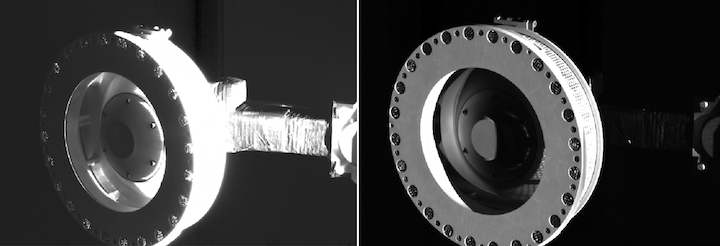
TAGSAM Sampler Head at Two Angles
These images show the OSIRIS-REx Touch-and-Go Sample Acquisition Mechanism (TAGSAM) sampling head extended from the spacecraft at the end of the TAGSAM arm. The spacecraft’s SamCam camera captured the images on Nov. 14, 2018 as part of a visual checkout of the TAGSAM system, which was developed by Lockheed Martin Space to acquire a sample of asteroid material in a low-gravity environment. The imaging was a rehearsal for a series of observations that will be taken at Bennu directly after sample collection.
In the image on the left, the TAGSAM head is tilted at five degrees on the arm and is brightly illuminated by the Sun. At this angle, the light saturates the lattice-like grille that surrounds the head and illuminates its interior, providing the lighting conditions needed to document the sample of Bennu once collected. In the image on the right, the TAGSAM head is aligned with the arm to clearly show the bottom surface of the head, including the metallic pads designed to capture additional dust and small particles from Bennu’s surface.
Quelle: NASA
----
Update: 17.50 MEZ
....
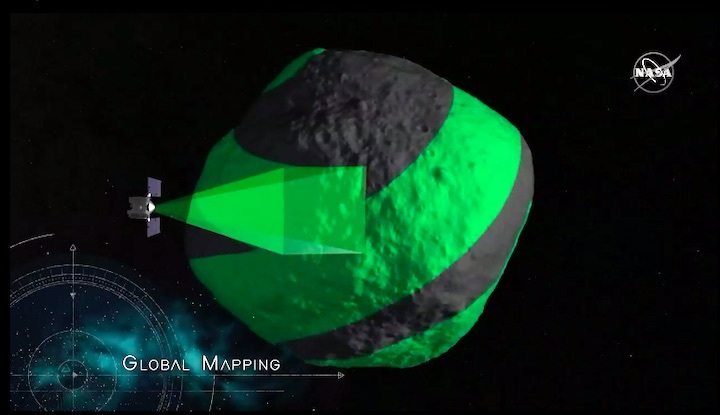
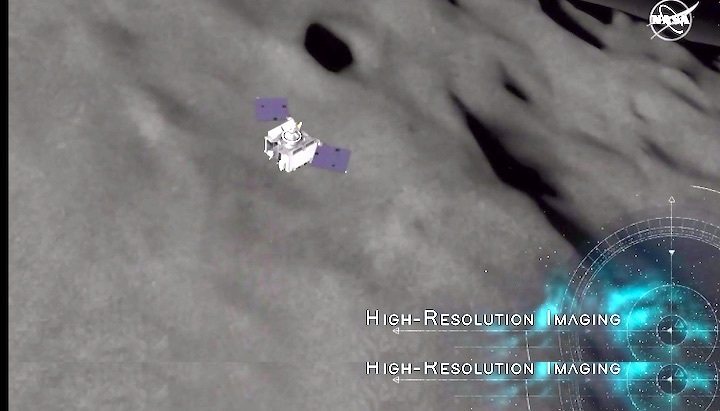
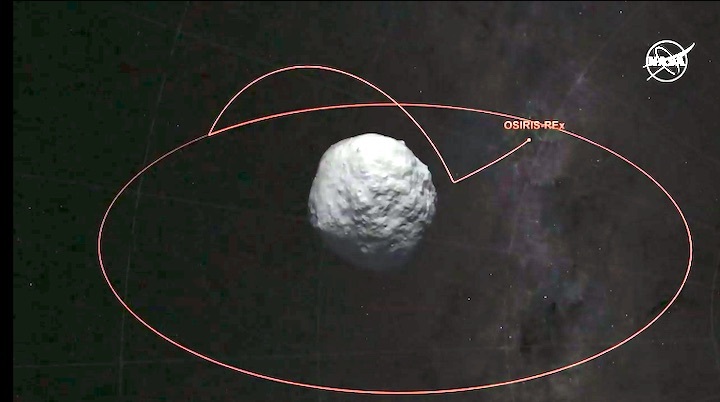
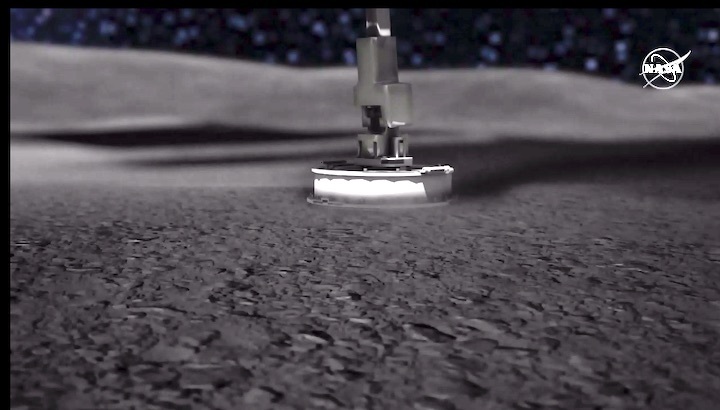
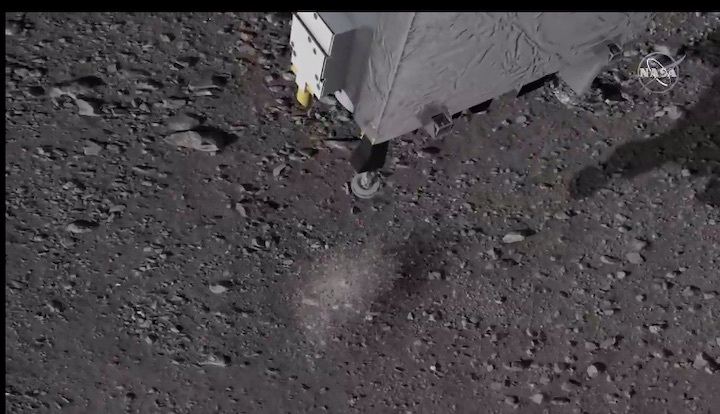
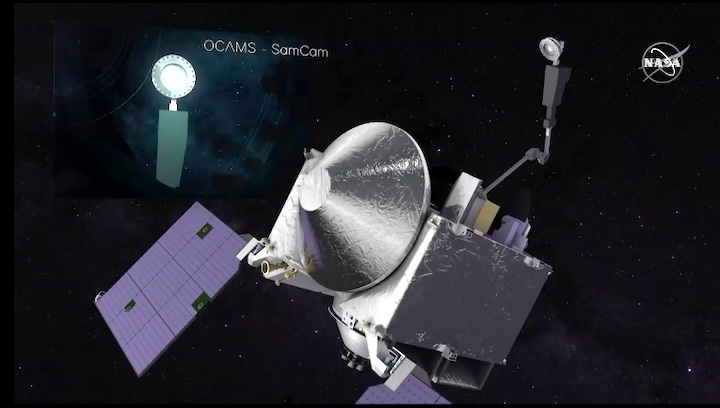
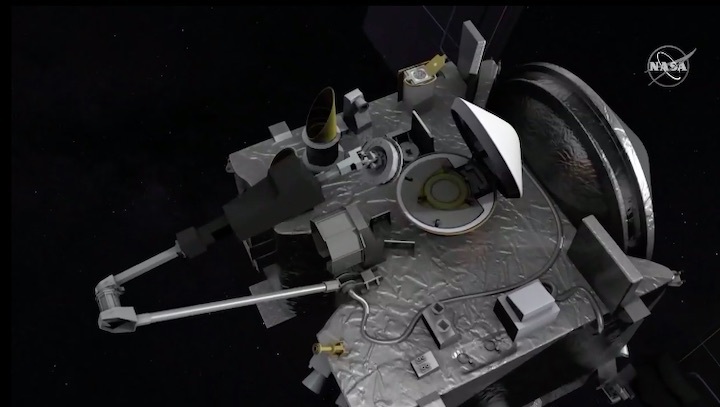
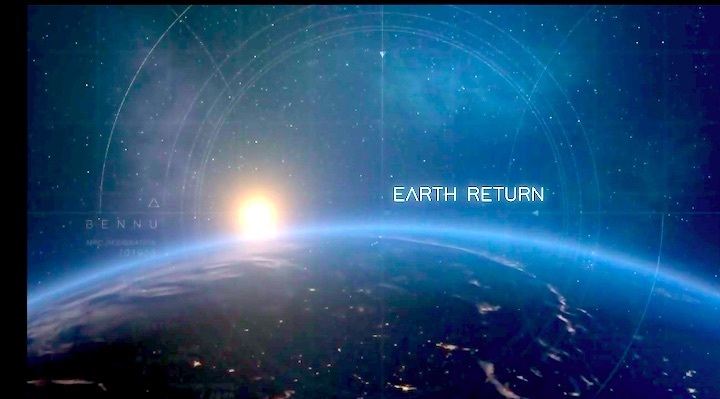
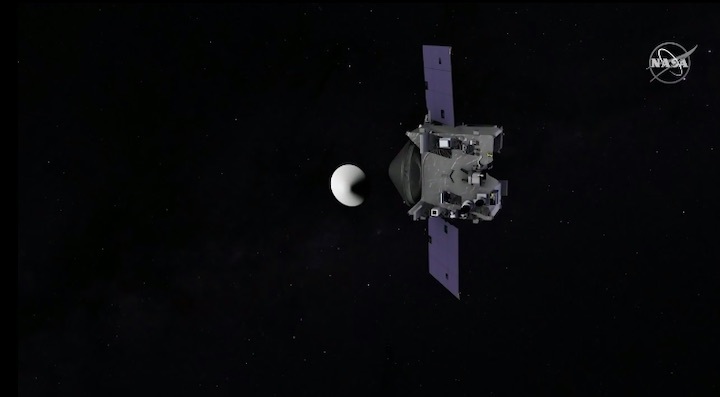
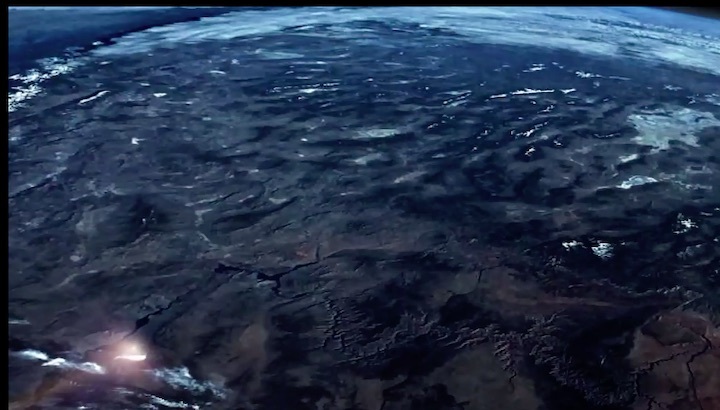
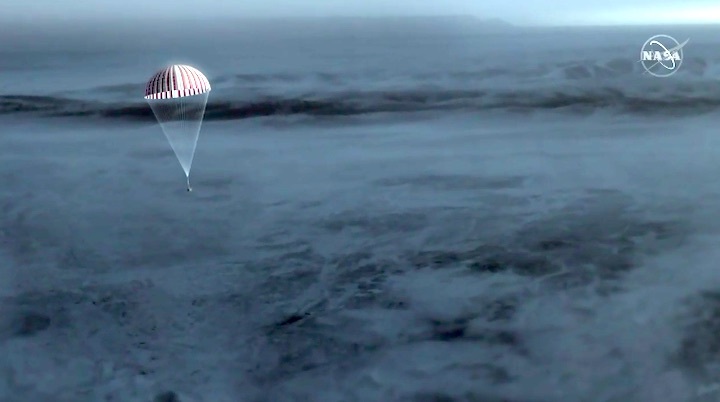
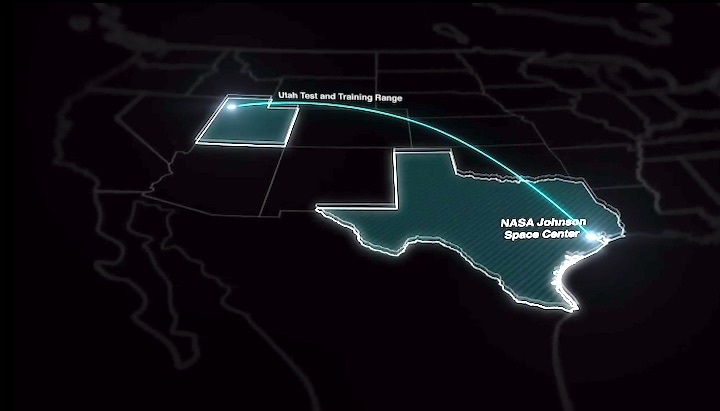
++++
LIVE-Frams NASA-TV
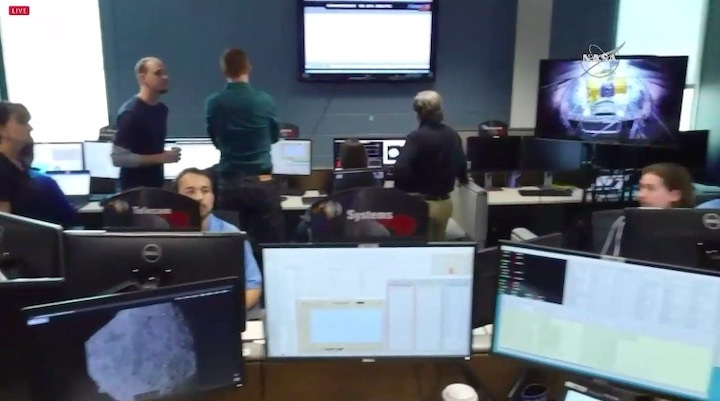
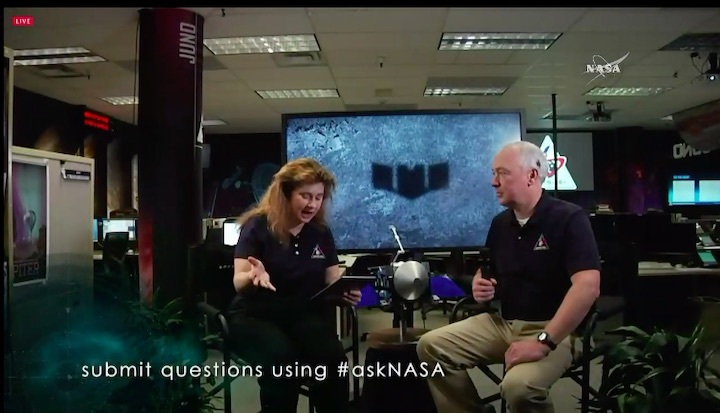
+++
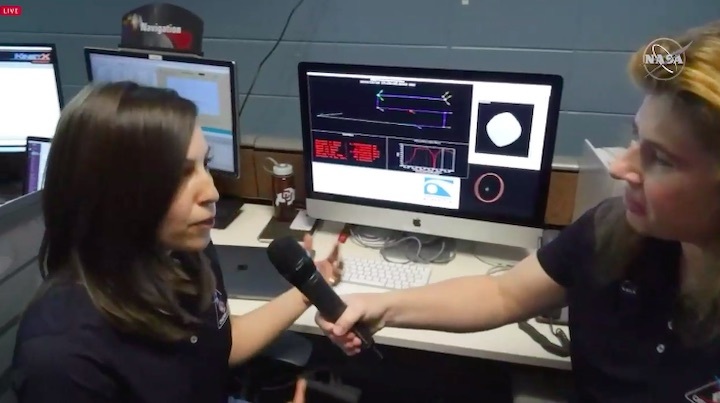
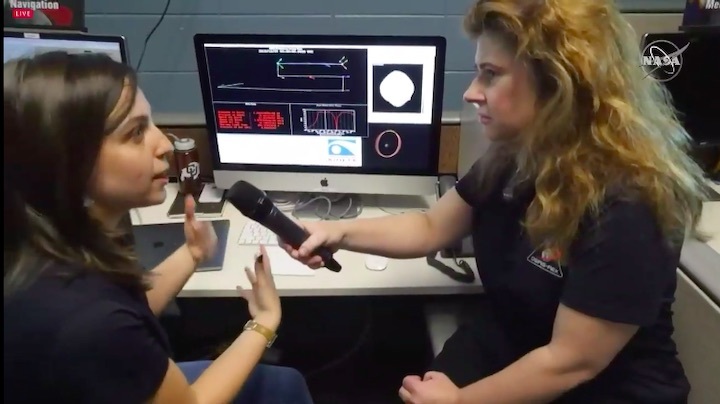
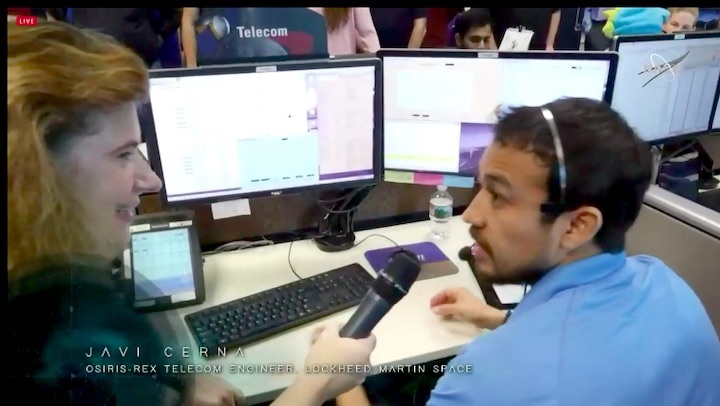
+++
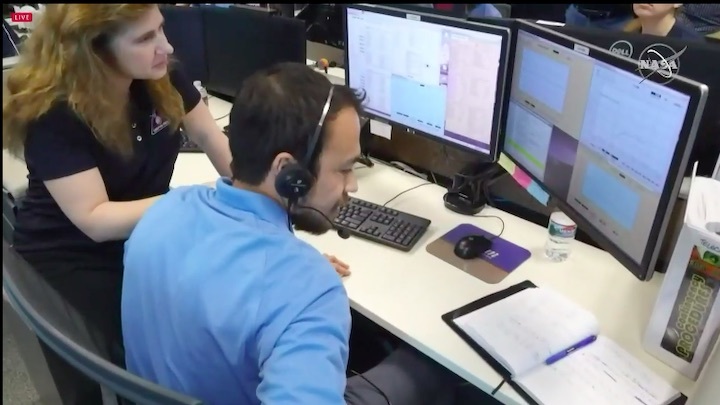
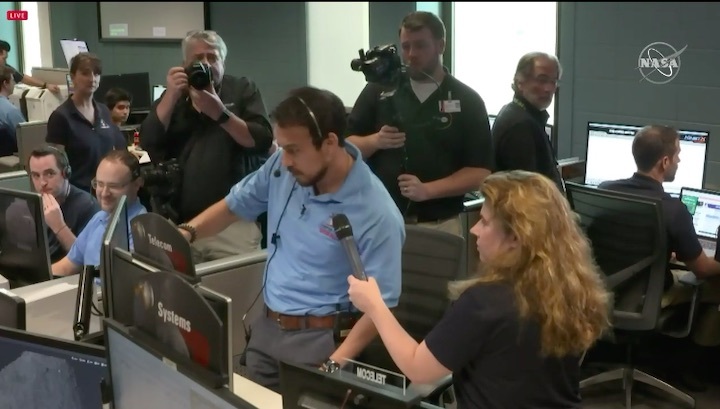
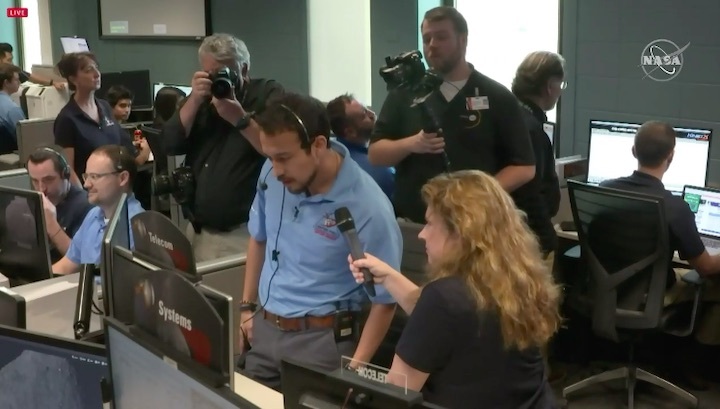
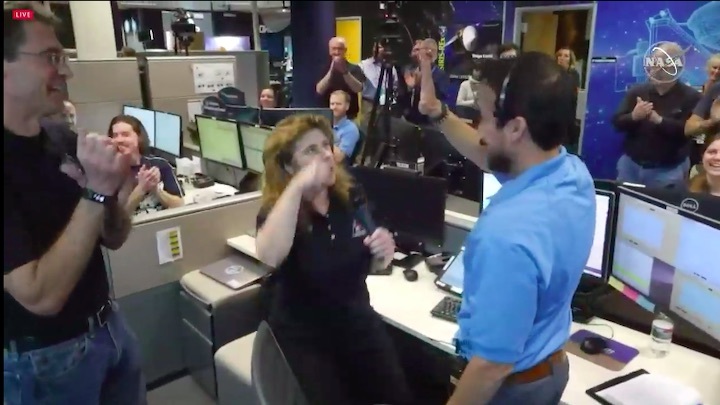
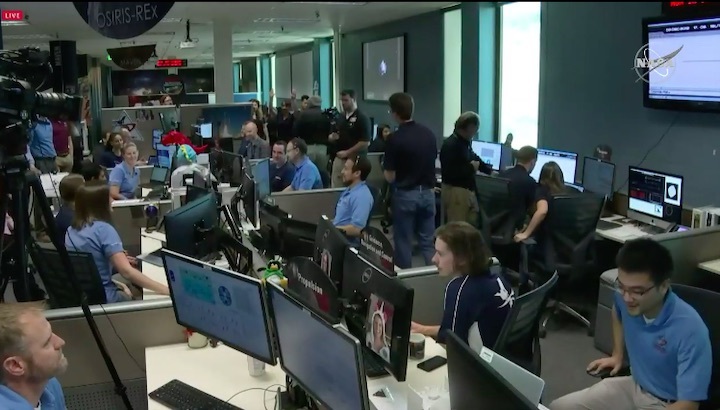
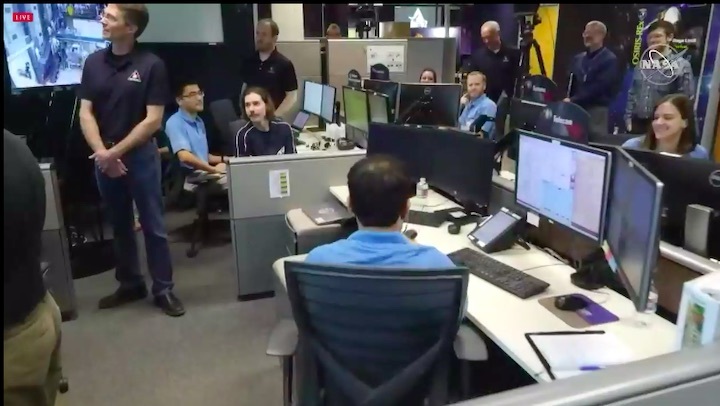
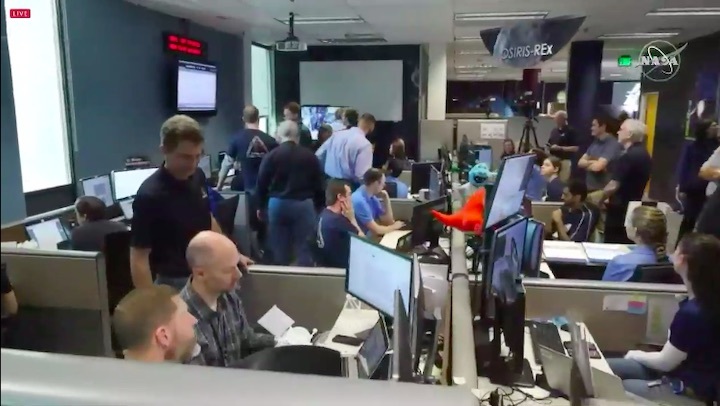
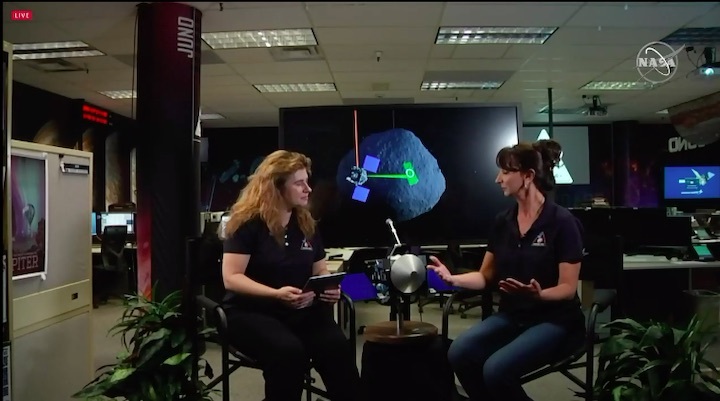
+++
After traveling through space for more than two years and over two billion miles, NASA’s Origins, Spectral Interpretation, Resource Identification, Security-Regolith Explorer (OSIRIS-REx) spacecraft arrived at its destination, asteroid Bennu, on Monday, Dec. 3, 2018. The spacecraft will spend almost a year surveying the asteroid with five scientific instruments with the goal of selecting a location that is safe and scientifically interesting to collect the sample. OSIRIS-REx will return the sample to Earth in September 2023.
Bennu Approach Fly In
Asteroid Rotation
Quelle: NASA
----
Update: 4.12.2018
.
Nasa probe reaches Bennu – asteroid that could one day hit Earth
Osiris-Rex spacecraft will eventually scoop up material for analysis back home
After a two-year chase, a Nasa probe has reached the ancient asteroid Bennu. The robotic explorer Osiris-Rex pulled within 12 miles (19km) of the diamond-shaped object on Monday and will go into orbit around it on 31 December. No spacecraft has ever orbited such a small body.
Bennu is considered a potentially hazardous asteroid – it is due to make a close pass of Earth about 150 years. If it collided with Earth, Bennu would probably cause a crater.
Osiris-Rex aims to collect at least 60 grams (two ounces) of dust and gravel, the first such attempt by the US after a smaller mission to another asteroid by Japan. The spacecraft won’t land but use a three-metre mechanical arm in 2020 to momentarily touch down and pick up particles. The sample container is planned to break loose and head toward Earth in 2021.
The collection – parachuting down to Utah – would represent the biggest such haul since the Apollo astronauts hand-delivered moon rocks to Earth in the late 1960s and early 1970s.
Scientists hope to learn more about the source of water in the solar system and the origins of organic molecules from which life first arose. Getting their hands on pristine asteroid material might also yield clues about how to mine them for valuable materials and defend against wayward ones that might threaten Earth.
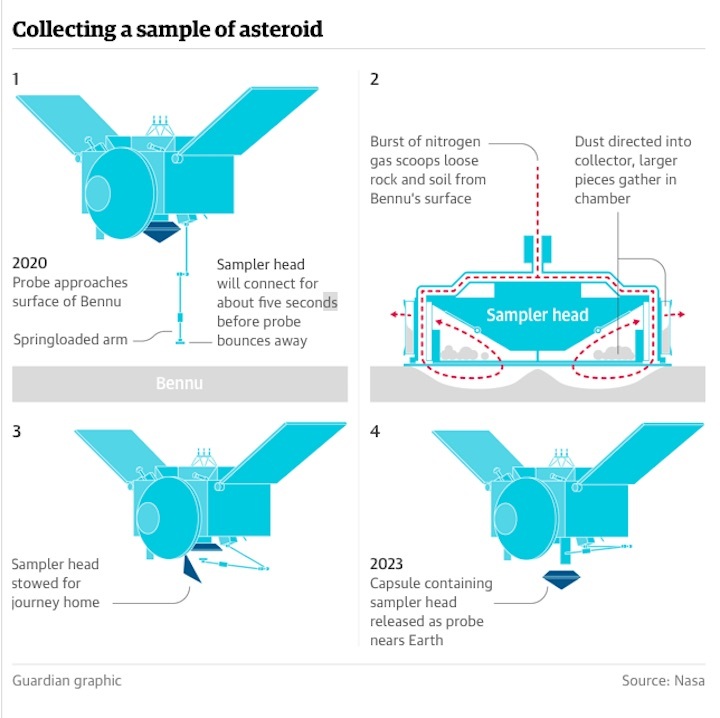
Flight controllers applauded and exchanged high-fives on Monday once confirmation came through that Osiris-Rex made it to Bennu – exactly one week after Nasa landed a spacecraft on Mars.
“Relieved, proud, and anxious to start exploring!” tweeted lead scientist Dante Lauretta of the University of Arizona. “To Bennu and back!”
Bennu is 76m miles (122m km) away so it took seven minutes for word of the success to reach flight controllers at Lockheed Martin in Littleton, Colorado, where the spacecraft was built.
Bennu is estimated to be just over 1,600ft (500 metres) across. Researchers will provide a more precise description at a scientific meeting on Monday next week in Washington.
About the size of a large car, the spacecraft will shadow the asteroid for a year, before scooping up some gravel for return to Earth in 2023.
A Japanese spacecraft, meanwhile, has been hanging out at another near-Earth asteroid since June, also for samples. It is Japan’s second asteroid mission. This latest rock is named Ryugu and is about double the size of Bennu.
Ryugu’s specks should be here by December 2020 but will be far less than Osiris-Rex’s promised booty.
Nasa has brought back comet dust and solar wind particles before but never asteroid samples. Japan managed to return some tiny particles in 2010 from its first asteroid mission, named Hayabusa.
Contact with Bennu will not significantly change its orbit or make it more dangerous to Earth, Lauretta stressed.
The $800m Osiris-Rex mission began with a 2016 launch from Cape Canaveral, Florida. Its odometer read 1.2bn miles (2bn km) as of Monday.
Both the spacecraft and asteroid’s names come from Egyptian mythology. Osiris is the god of the afterlife, while Bennu represents the heron and creation.
Osiris-Rex is actually a Nasa acronym for origins, spectral interpretation, resource identification, security-regolith explorer.
Quelle: The Guardian
+++
NASA's OSIRIS-REx Spacecraft Arrives at Asteroid Bennu
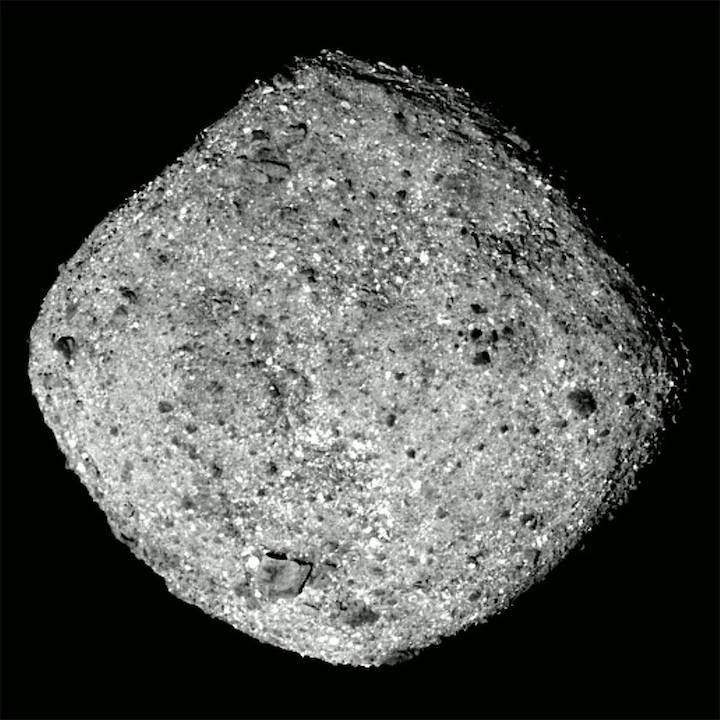
NASA’s Origins, Spectral Interpretation, Resource Identification, Security-Regolith Explorer (OSIRIS-REx) spacecraft completed its 1.2 billion-mile (2 billion-kilometer) journey to arrive at the asteroid Bennu Monday. The spacecraft executed a maneuver that transitioned it from flying toward Bennu to operating around the asteroid.
Now, at about 11.8 miles (19 kilometers) from Bennu’s Sun-facing surface, OSIRIS-REx will begin a preliminary survey of the asteroid. The spacecraft will commence flyovers of Bennu’s north pole, equatorial region, and south pole, getting as close as nearly 4 miles (7 kilometers) above Bennu during each flyover.
The primary science goals of this survey are to refine estimates of Bennu’s mass and spin rate, and to generate a more precise model of its shape. The data will help determine potential sites for later sample collection.
OSIRIS-REx’s mission will help scientists investigate how planets formed and how life began, as well as improve our understanding of asteroids that could impact Earth. Asteroids are remnants of the building blocks that formed the planets and enabled life. Those like Bennu contain natural resources, such as water, organics and metals. Future space exploration and economic development may rely on asteroids for these materials.
“As explorers, we at NASA have never shied away from the most extreme challenges in the solar system in our quest for knowledge,” said Lori Glaze, acting director for NASA’s Planetary Science Division. “Now we’re at it again, working with our partners in the U.S. and Canada to accomplish the Herculean task of bringing back to Earth a piece of the early solar system.”
The mission’s navigation team will use the preliminary survey of Bennu to practice the delicate task of navigating around the asteroid. The spacecraft will enter orbit around Bennu on Dec. 31 --thus making Bennu, which is only about 1,600 feet (492 meters) across -- or about the length of five football fields -- the smallest object ever orbited by a spacecraft. It’s a critical step in OSIRIS-REx’s years-long quest to collect and eventually deliver at least two ounces (60 grams) of regolith -- dirt and rocks -- from Bennu to Earth.
Starting in October, OSIRIS-REx performed a series of braking maneuvers to slow the spacecraft down as it approached Bennu. These maneuvers also targeted a trajectory to set up Monday’s maneuver, which initiates the first north pole flyover and marks the spacecraft's arrival at Bennu.
“The OSIRIS-REx team is proud to cross another major milestone off our list -- asteroid arrival,” said Dante Lauretta, OSIRIS-REx principal investigator at the University of Arizona, Tucson. “Initial data from the approach phase show this object to have exceptional scientific value. We can’t wait to start our exploration of Bennu in earnest. We’ve been preparing for this moment for years, and we’re ready.”
OSIRIS-REx mission marks many firsts in space exploration. It will be the first U.S. mission to carry samples from an asteroid back to Earth and the largest sample returned from space since the Apollo era. It’s the first to study a primitive B-type asteroid, which is an asteroid that’s rich in carbon and organic molecules that make up life on Earth. It is also the first mission to study a potentially hazardous asteroid and try to determine the factors that alter their courses to bring them close to Earth.
“During our approach toward Bennu, we have taken observations at much higher resolution than were available from Earth,” said Rich Burns, the project manager of OSIRIS-REx at NASA’s Goddard Space Flight Center in Greenbelt, Maryland. “These observations have revealed an asteroid that is both consistent with our expectations from ground-based measurements and an exceptionally interesting small world. Now we embark on gaining experience flying our spacecraft about such a small body."
When OSIRIS-REx begins to orbit Bennu at the end of this month, it will come close to approximately three quarters of a mile (1.25 kilometers) to its surface. In February 2019, the spacecraft begins efforts to globally map Bennu to determine the best site for sample collection. After the collection site is selected, the spacecraft will briefly touch the surface of Bennu to retrieve a sample. OSIRIS-REx is scheduled to return the sample to Earth in September 2023.
Goddard provides overall mission management, systems engineering and the safety and mission assurance for OSIRIS-REx. Dante Lauretta of the University of Arizona, Tucson, is the principal investigator, and the University of Arizona also leads the science team and the mission’s science observation planning and data processing. Lockheed Martin Space in Denver built the spacecraft and is providing flight operations. Goddard and KinetX Aerospace are responsible for navigating the OSIRIS-REx spacecraft. OSIRIS-REx is the third mission in NASA’s New Frontiers Program, which is managed by NASA’s Marshall Space Flight Center in Huntsville, Alabama for the agency’s Science Mission Directorate in Washington.
Quelle: NASA
----
Update: 7.12.2018
.
Planetary Defense: The Bennu Experiment
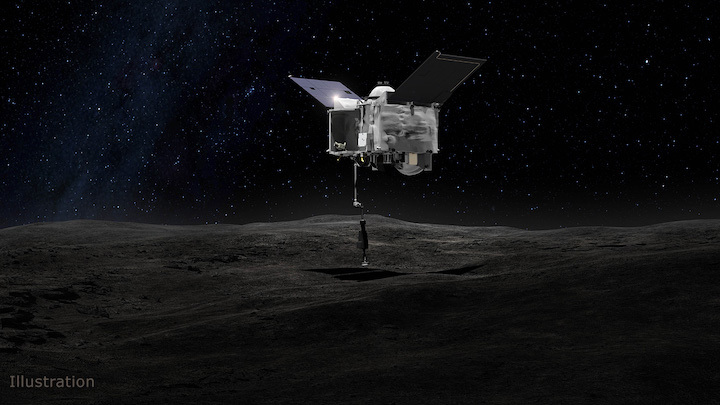
This artist's concept shows the Origins Spectral Interpretation Resource Identification Security - Regolith Explorer (OSIRIS-REx) spacecraft contacting the asteroid Bennu with the Touch-And-Go Sample Arm Mechanism or TAGSAM. The mission aims to return a sample of Bennu's surface coating to Earth for study as well as return detailed information about the asteroid and it's trajectory.Credits: NASA's Goddard Space Flight Center
On Dec. 3, after traveling billions of kilometers from Earth, NASA's OSIRIS-REx spacecraft reached its target, Bennu, and kicked off a nearly two-year, up-close investigation of the asteroid. It will inspect nearly every square inch of this ancient clump of rubble left over from the formation of our solar system. Ultimately, the spacecraft will pick up a sample of pebbles and dust from Bennu's surface and deliver it to Earth in 2023.
Generations of planetary scientists will get to study pieces of the primitive materials that formed our cosmic neighborhood and to better understand the role asteroids may have played in delivering life-forming compounds to planets and moons.
But it's not just history that the mission to Bennu will help uncover. Scientists studying the rock through OSIRIS-REx's instruments in space will also shape our future. As they collect the most detailed information yet about the forces that move asteroids, experts from NASA's Planetary Defense Coordination Office, who are responsible for detecting potentially hazardous asteroids, will improve their predictions of which ones could be on a crash-course with our planet.
Here is how the OSIRIS-REx mission will support this work:
How scientists predict Bennu's whereabouts
About a third of a mile, or half a kilometer, wide, Bennu is large enough to reach Earth's surface; many smaller space objects, in contrast, burn up in our atmosphere. If it impacted Earth, Bennu would cause widespread damage. Asteroid experts at the Center for Near-Earth Object Studies (CNEOS) at NASA's Jet Propulsion Laboratory in Pasadena, California, project that Bennu will come close enough to Earth over the next century to pose a 1 in 2,700 chance of impacting it between 2175 and 2196. Put another way, those odds mean there is a 99.963 percent chance the asteroid will miss the Earth. Even so, astronomers want to know exactly where Bennu is located at all times.
Astronomers have estimated Bennu's future trajectory after observing it several times since it was discovered in 1999. They've turned their optical, infrared and radio telescopes toward the asteroid every time it came close enough to Earth, about every six years, to deduce features such as its shape, rotation rate and trajectory.
"We know within a few kilometers where Bennu is right now," said Steven Chesley, senior research scientist at CNEOS and an OSIRIS-REx team member whose job it is to predict Bennu's future trajectory.
Why Bennu's future trajectory predictions get fuzzy
Scientists have estimated Bennu's trajectory around the Sun far into the future. Their predictions are informed by ground observations and mathematical calculations that account for the gravitational nudging of Bennu by the Sun, the Moon, planets and other asteroids, plus non-gravitational factors.
Given these parameters, astronomers can predict the next four exact dates (in September of 2054, 2060, 2080 and 2135) that Bennu will come within 5 million miles (7.5 million kilometers or .05 astronomical units) of Earth. That's close enough that Earth's gravity will slightly bend Bennu's orbital path as it passes by. As a result, the uncertainty about where the asteroid will be each time it loops back around the Sun will grow, causing predictions about Bennu's future orbit to become increasingly hazy after 2060.
In 2060, Bennu will pass Earth at about twice the distance from here to the Moon. But it could pass at any point in a 19-mile (30-kilometer) window of space. A very small difference in position within that window will get magnified enormously in future orbits and make it increasingly hard to predict Bennu's trajectory.
As a result, when this asteroid comes back near Earth in 2080, according to Chesley's calculations, the best window we can get on its whereabouts is nearly 9,000 miles (14,000 kilometers) wide. By 2135, when Bennu's shifted orbit is expected to bring it closer than the Moon, its flyby window grows wider, to nearly 100,000 miles (160,000 kilometers). This will be Bennu's closest approach to Earth over the five centuries for which we have reliable calculations.
"Right now, Bennu has the best orbit of any asteroid in our database," Chesley said. "And yet, after that encounter in 2135, we really can't say exactly where it is headed."
There's another phenomenon nudging Bennu's orbit and muddying future impact projections. It's called the Yarkovsky effect. Having nothing to do with gravity, the Yarkovsky effect sways Bennu's orbit because of heat from the Sun.
"There are a lot of factors that might affect the predictability of Bennu's trajectory in the future, but most of them are relatively small," says William Bottke, an asteroid expert at the Southwest Research Institute in Boulder, Colorado, and a participating scientist on the OSIRIS-REx mission. "The one that's most sizeable is Yarkvovsky."
This heat nudge was named after the Polish civil engineer who first described it in 1901: Ivan Osipovich Yarkovsky. He suggested that sunlight warms one side of a small, dark asteroid and some hours later radiates that heat away as the asteroid rotates its hot side into cold darkness. This thrusts the rock pile a bit, either toward the Sun or away from it, depending on the direction of its rotation.
In Bennu's case, astronomers have calculated that the Yarkovsky effect has shifted its orbit about 0.18 miles (284 meters) per year toward the Sunsince 1999. In fact, it helped deliver Bennu to our part of the solar system, in the first place, from the asteroid belt between Mars and Jupiter over billions of years. Now, Yarkovsky is complicating our efforts to make predictions about Bennu's path relative to Earth.
Getting face-to-face with the asteroid will help
The OSIRIS-REx spacecraft will use its suite of instruments to transmit radio tracking signals and capture optical images of Bennu that will help NASA scientists determine its precise position in the solar system and its exact orbital path. Combined with existing, ground-based observations, the space measurements will help clarify how Bennu's orbit is changing over time.
Additionally, astronomers will get to test their understanding of the Yarkovksy effect on a real-life asteroid for the first time. They will instruct the spacecraft to follow Bennu in its orbit about the Sun for about two years to see whether it's moving along an expected path based on gravity and Yarkovsky theories. Any differences between the predictions and reality could be used to refine models of the Yarkovsky effect.
But even more significant to understanding Yarkovsky better will be the thermal measurements of Bennu. During its mission, OSIRIS-REx will track how much solar heat radiates off the asteroid, and where on the surface it's coming from-data that will help confirm and refine calculations of the Yarkovsky effect on asteroids.
The spacecraft also will address some open questions about the Yarkovsky theory. One of them, said Chesley, is how do boulders and craters on the surface of an asteroid change the way photons scatter off of it as it cools, carrying away momentum from the hotter side and thereby nudging the asteroid in the opposite direction? OSIRIS-REx will help scientists understand by mapping the rockiness of Bennu's surface.
"We know surface roughness is going to affect the Yarkovsky effect; we have models" said Chesley. "But the models are speculative. No one has been able to test them."
After the OSIRIS-REx mission, Chesley said, NASA's trajectory projections for Bennu will be about 60 times better than they are now.
Quelle: NASA
----
Update: 8.12.2018
.
NASA Highlights Asteroid Bennu, Earth’s Polar Ice at AGU Meeting
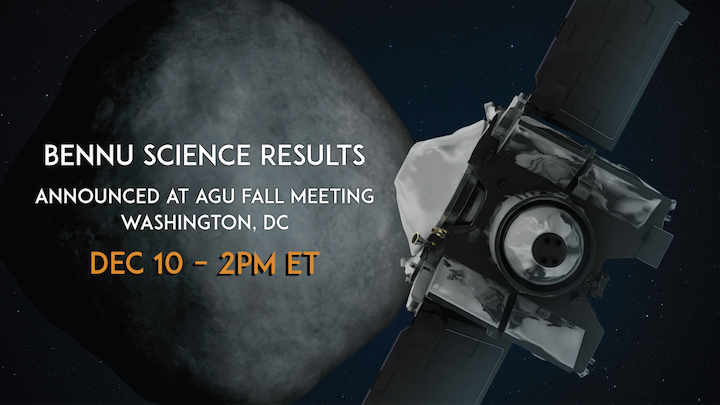
NASA researchers will present new findings on a wide range of Earth and space science topics at the annual meeting of the American Geophysical Union (AGU), Dec. 10-14 in Washington. NASA-related briefings will stream live on the agency’s website.
Media registration is open for the event, which will be held at the Walter E. Washington Convention Center at 801 Mt. Vernon Place NW.
Briefing topics include: the latest findings from the Origins, Spectral Interpretation, Resource Identification, Security-Regolith Explorer (OSIRIS-Rex) mission to asteroid Bennu and the new Ice, Cloud and land Elevation Satellite-2 (ICESat-2) Earth-observing mission; the lingering impact of Hurricane Maria on Puerto Rico; and an update on Voyager 2 at the edge of the solar system.
Agency scientists, and their colleagues who use NASA research capabilities, also will present noteworthy findings during scientific sessions that are open to registered media.
Details on NASA presentations will be updated online throughout the week. For a complete and up-to-date schedule of briefings and media participation information, visit: https://www.nasa.gov/agu
Quelle: NASA
----
Update: 9.12.2018
.
Canada begins mapping asteroid Bennu
Media advisory
OSIRIS-REx's first science data to be presented during the American Geophysical Union 2018 Fall Meeting
Longueuil, Quebec, December 7, 2018 — On December 10, the American Geophysical Union (AGU) will be hosting a press conference presenting the first science data obtained from asteroid Bennu by the OSIRIS-REx mission, to which the Canadian Space Agency (CSA) has contributed the most sophisticated scanning lidar ever flown to space: the OSIRIS-REx Laser Altimeter (OLA).
Shortly after the spacecraft's arrival at Bennu on December 3, OLA began scanning the asteroid's surface. Results will help scientists identify and select the best site to collect a sample.
Canada will receive a portion of the returned asteroid material, allowing Canada's scientific community to conduct investigations that will help unravel the asteroid's physical, chemical, and geological mysteries.
Media representatives are invited to connect to the press conference.
Date:
December 10, 2018
Time:
2:00 p.m. ET
What:
Press conference on OSIRIS-REx, an asteroid sample-return mission
Who:
Jeff Grossman, NASA Headquarters, Washington, D.C., U.S.A.
Dante Lauretta, University of Arizona, Tucson, Arizona, U.S.A.
Michael Nolan, University of Arizona, Tucson, Arizona, U.S.A.
Amy Simon, NASA Goddard Space Flight Center, Greenbelt, Maryland, U.S.A.
Where:
Webstreaming on the AGU's press conference webpage
Quelle: Canadian Space Agency
----
Update: 11.12.2018
.
NASA’s Newly Arrived OSIRIS-REx Spacecraft Already Discovers Water on Asteroid
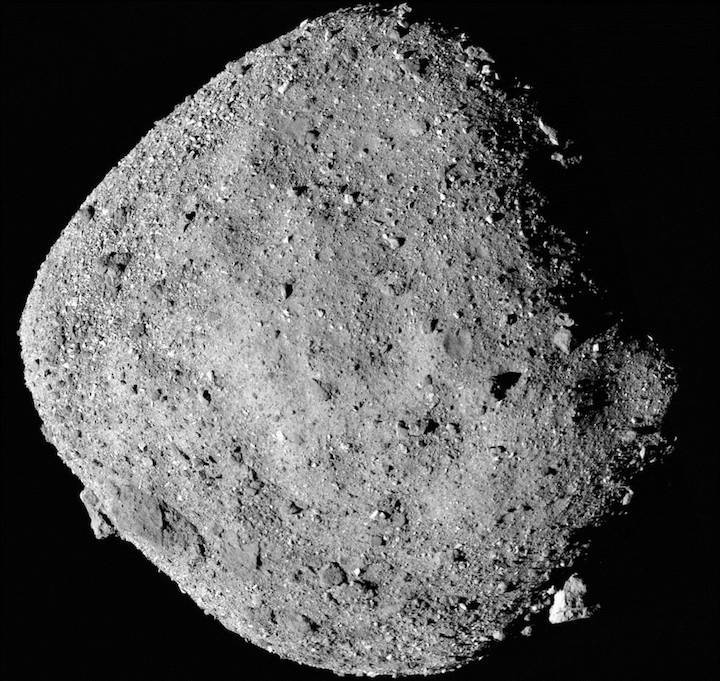
Recently analyzed data from NASA’s Origins, Spectral Interpretation, Resource Identification, Security-Regolith Explorer (OSIRIS-REx) mission has revealed water locked inside the clays that make up its scientific target, the asteroid Bennu.
During the mission’s approach phase, between mid-August and early December, the spacecraft traveled 1.4 million miles (2.2 million km) on its journey from Earth to arrive at a location 12 miles (19 km) from Bennu on Dec. 3. During this time, the science team on Earth aimed three of the spacecraft’s instruments towards Bennu and began making the mission’s first scientific observations of the asteroid. OSIRIS-REx is NASA’s first asteroid sample return mission.
Data obtained from the spacecraft’s two spectrometers, the OSIRIS-REx Visible and Infrared Spectrometer (OVIRS) and the OSIRIS-REx Thermal Emission Spectrometer (OTES), reveal the presence of molecules that contain oxygen and hydrogen atoms bonded together, known as “hydroxyls.” The team suspects that these hydroxyl groups exist globally across the asteroid in water-bearing clay minerals, meaning that at some point, Bennu’s rocky material interacted with water. While Bennu itself is too small to have ever hosted liquid water, the finding does indicate that liquid water was present at some time on Bennu’s parent body, a much larger asteroid.
“The presence of hydrated minerals across the asteroid confirms that Bennu, a remnant from early in the formation of the solar system, is an excellent specimen for the OSIRIS-REx mission to study the composition of primitive volatiles and organics,” said Amy Simon, OVIRS deputy instrument scientist at NASA’s Goddard Space Flight Center in Greenbelt, Maryland. “When samples of this material are returned by the mission to Earth in 2023, scientists will receive a treasure trove of new information about the history and evolution of our solar system.”
Additionally, data obtained from the OSIRIS-REx Camera Suite (OCAMS) corroborate ground-based telescopic observations of Bennu and confirm the original model developed in 2013 by OSIRIS-REx Science Team Chief Michael Nolan and collaborators. That model closely predicted the asteroid’s actual shape, with Bennu’s diameter, rotation rate, inclination, and overall shape presented almost exactly as projected.
One outlier from the predicted shape model is the size of the large boulder near Bennu’s south pole. The ground-based shape model calculated this boulder to be at least 33 feet (10 meters) in height. Preliminary calculations from OCAMS observations show that the boulder is closer to 164 feet (50 meters) in height, with a width of approximately 180 feet (55 meters).
Bennu’s surface material is a mix of very rocky, boulder-filled regions and a few relatively smooth regions that lack boulders. However, the quantity of boulders on the surface is higher than expected. The team will make further observations at closer ranges to more accurately assess where a sample can be taken on Bennu to later be returned to Earth.
“Our initial data show that the team picked the right asteroid as the target of the OSIRIS-REx mission. We have not discovered any insurmountable issues at Bennu so far,” said Dante Lauretta, OSIRIS-REx principal investigator at the University of Arizona, Tucson. “The spacecraft is healthy and the science instruments are working better than required. It is time now for our adventure to begin.”
The mission currently is performing a preliminary survey of the asteroid, flying the spacecraft in passes over Bennu’s north pole, equator, and south pole at ranges as close as 4.4 miles (7 km) to better determine the asteroid’s mass. The mission’s scientists and engineers must know the mass of the asteroid in order to design the spacecraft’s insertion into orbit because mass affects the asteroid’s gravitational pull on the spacecraft. Knowing Bennu’s mass will also help the science team understand the asteroid’s structure and composition.
This survey also provides the first opportunity for the OSIRIS-REx Laser Altimeter (OLA), an instrument contributed by the Canadian Space Agency, to make observations, now that the spacecraft is in proximity to Bennu.
The spacecraft’s first orbital insertion is scheduled for Dec. 31, and OSIRIS-REx will remain in orbit until mid-February 2019, when it exits to initiate another series of flybys for the next survey phase. During the first orbital phase, the spacecraft will orbit the asteroid at a range of 0.9 miles (1.4 km) to 1.24 miles (2.0 km) from the center of Bennu — setting new records for the smallest body ever orbited by a spacecraft and the closest orbit of a planetary body by any spacecraft.
Goddard provides overall mission management, systems engineering and the safety and mission assurance for OSIRIS-REx. Dante Lauretta of the University of Arizona, Tucson, is the principal investigator, and the University of Arizona also leads the science team and the mission’s science observation planning and data processing. Lockheed Martin Space Systems in Denver built the spacecraft and is providing flight operations. Goddard and KinetX Aerospace are responsible for navigating the OSIRIS-REx spacecraft. OSIRIS-REx is the third mission in NASA’s New Frontiers Program. NASA’s Marshall Space Flight Center in Huntsville, Alabama, manages the agency’s New Frontiers Program for the Science Mission Directorate in Washington.
Quelle: NASA


